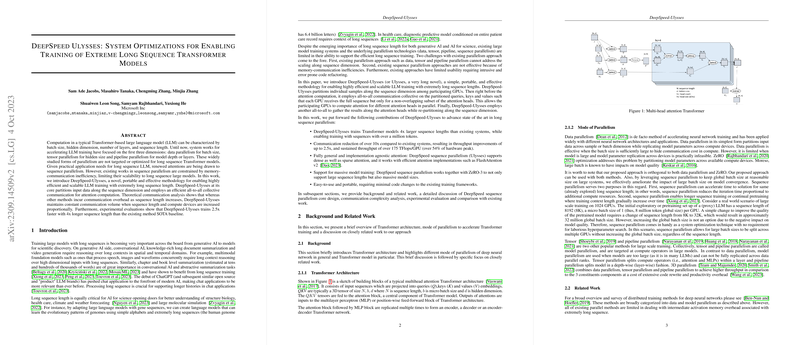Analysis of "DeepSpeed Ulysses: System Optimizations for Enabling Training of Extreme Long Sequence Transformer Models"
In the paper titled "DeepSpeed Ulysses: System Optimizations for Enabling Training of Extreme Long Sequence Transformer Models," the authors introduce a novel approach, DeepSpeed-Ulysses, designed to enhance the training of large-scale Transformer models with exceptionally long sequences. This paper addresses a critical challenge in Transformer model training: efficiently managing long sequence lengths without succumbing to communication and memory bottlenecks.
The traditional Transformer model computation is characterized by multiple dimensions: batch size, hidden dimension, number of layers, and sequence length. While data, tensor, and pipeline parallelism have received considerable attention for the first three dimensions, sequence length has not been adequately optimized, resulting in inefficiencies in scalability for models processing long sequences. DeepSpeed-Ulysses proposes an effective sequence parallelism method that partitions the input data along the sequence dimension and utilizes an all-to-all communication scheme for attention computation.
Technical Contributions
The core contributions of DeepSpeed-Ulysses are multifold:
- Increased Sequence Lengths: DeepSpeed-Ulysses supports training with sequences 4x longer than existing systems. This is achieved without sacrificing throughput, which is improved by up to 2.5x over previous state-of-the-art (SOTA) methods.
- Efficient Communication Model: The system manages to maintain a constant communication volume even as sequence length and computing devices scale proportionally. This distinguishes it from other methods, where communication overhead grows with sequence length.
- Broad Attention Agnosticism: DeepSpeed-Ulysses is compatible with both dense and sparse attention mechanisms, including advanced versions like FlashAttention v2, making it versatile across different attention implementations.
- Scalable Model Training: The system integrates with ZeRO-3 to facilitate not only long sequence lengths but also massive model sizes, supporting large Transformer models efficiently.
- Usability and Portability: Minimal changes are required to incorporate DeepSpeed-Ulysses into existing frameworks, ensuring ease of integration and broad applicability.
Implications and Future Directions
The implications of this research are significant for both practical applications and theoretical advancements in AI. By enabling efficient long-sequence Transformer training, DeepSpeed-Ulysses opens opportunities for improved performance in applications such as conversational AI, video generation, and multi-modal models that concurrently process diverse input types like speech, images, and text. Moreover, in scientific domains, the ability to work with very long sequences can enhance understanding in areas such as genomics, healthcare, and climate modeling.
Theoretically, this advancement might influence future architecture designs, encouraging more research into optimizing models for extensive sequences. It could inspire further improvement in sequence parallelism techniques and the exploration of novel training strategies that leverage these capabilities.
Numerical Results
The empirical results presented in the paper substantiate the efficacy of DeepSpeed-Ulysses. The method maintains over 54% of hardware peak performance with a throughput exceeding 175 TFlops/GPU, demonstrating robust scaling capabilities. Experiments show that the system allows for scaling sequence lengths linearly with the number of GPUs, achieving significant improvements over existing methods like Megatron-LM.
Conclusion
DeepSpeed-Ulysses represents a pivotal step toward overcoming the sequence parallelism challenge in training large Transformer models. The methodological innovations and empirical successes outlined in the paper present a compelling case for adopting DeepSpeed-Ulysses in domains requiring high-efficiency long-sequence processing. It sets a promising foundation for future work aimed at further optimizing communication and memory handling in large-scale AI models, potentially leading to transformative advancements across AI applications.
